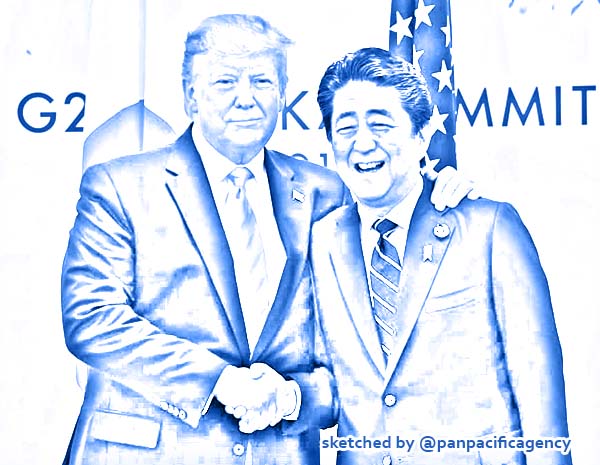Japan, US ink bilateral trade agreement

U.S. President Donald Trump shakes hands with Prime Minister Shinzo Abe during the Group of 20 leaders summit in Osaka on Friday. | REUTERS / VIA KYODO. Sketched by the Pan Pacific Agency.
NEW YORK, Sep 25, 2019, Kyodo. Japanese Prime Minister Shinzo Abe and U.S. President Donald Trump reached a bilateral trade agreement on Wednesday designed to cut tariffs on farm and industrial products, with both leaders touting benefits to be gained from the deal, reported the Kyodo.
Still, the pact is seen to represent a victory for Trump, who has sought to reduce his country’s trade deficits and forge bilateral agreements promoting what his administration has termed “fair and reciprocal” trade.
Japan is viewed as having made more concessions than the United States amid Washington’s threat of higher tariffs on Japanese auto imports.
“The prime minister and I will sign a document outlining the significant steps we’re taking toward a fair and reciprocal trade agreement,” Trump said alongside Abe, calling it a “huge victory” for American farmers and ranchers.
Japanese tariffs will be significantly lower or eliminated for the United States, Trump said, adding that the accord will open new markets and help reduce his country’s chronic trade deficit. But he also indicated that talks to conclude a more “comprehensive” deal will continue.
Abe expressed his confidence that the deal will bring benefits to both countries.
“When the pact enters into force, there is no doubt that Japanese investments will increase and both of our economies will grow,” he said.
“I’m confident that it will be something of a win-win for both countries,” the prime minister said as both sides sought to defend their respective national interests during the negotiations.
Reduced taxes on U.S. beef and pork are expected to benefit U.S. farmers who feel disadvantaged compared with foreign rivals due to multiparty frameworks, including the revised Trans-Pacific Partnership free trade pact that has been attacked by Trump.
Japanese consumers, meanwhile, would gain access to potentially cheaper U.S. meat, wheat, wine and other products imported under the envisaged trade deal.
If the trade pact takes effect, Japan is expected to, among other things, lower its current 38.5 percent tariff on U.S. beef imports immediately to 26.6 percent, setting the rate on par with Australia and others that joined the revised TPP pact. The tariff on U.S. beef imports will likely be further reduced in stages to 9 percent.
Auto tariffs have been the major focal point of the negotiations that began in April after the United States threatened to impose higher tariffs on Japanese auto imports citing national security reasons.
The focus is on whether Abe can secure an assurance from Trump that Japan will continue to be exempted from such auto tariffs under Section 232 of the U.S. Trade Expansion Act.
Toshimitsu Motegi, the new foreign minister who has led Japan’s negotiating team, said in the run-up to the summit, he expected the United States would make that promise in writing.
In a potential setback for the auto industry that is the backbone of the export-reliant economy, the United States is expected to maintain its current 2.5 percent tariff on U.S.-bound Japanese cars and auto parts, negotiation sources have said.
In talks with the United States, Japan maintained that it would not commit to bigger concessions than those already made in existing free trade agreements, such as the revised 11-member TPP, as it fought to protect the interests of domestic farmers.
In the deal, Japan appears to have won U.S. concessions on rice, a politically sensitive area for the country.
Tokyo is unlikely to offer Washington a tariff-free rice quota for American rice of up to 70,000 tons a year, which the administration of former U.S. President Barack Obama had secured when it signed the original TPP with Japan and 10 other regional economies in 2016, according to the sources.
Trump withdrew the United States from the TPP in 2017, citing his preference for bilateral trade deals.
The new agreement would also pave the way for more Japanese beef to enter the U.S. market by removing the current low-tariff quota set at 200 tons a year.